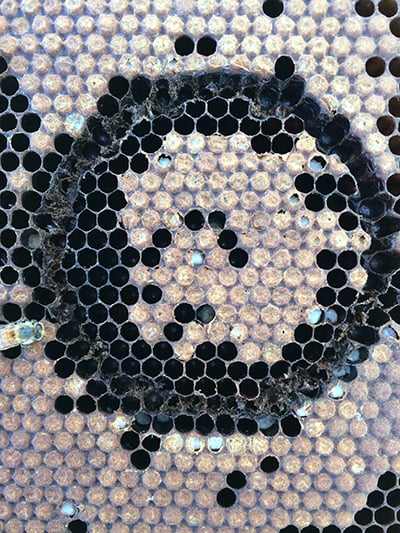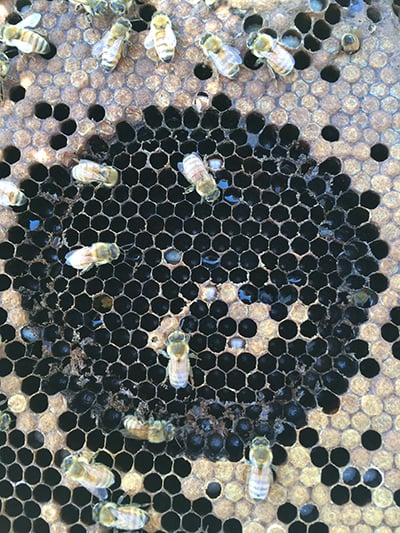For a colony to show hygienic behaviour, there are three things the workers must do.
- The first is detection: a worker bee must sense that the capped brood is dead or diseased.
- Secondly, a worker must uncap the cell.
- The final step is removing the brood from the cell and the colony.
Benefits of hygienic behaviour
Hygienic behaviour can reduce the spread of American foulbrood (AFB) if infected pupae are removed before the AFB bacteria sporulate; that is, within 9 days of egg hatching.
It is unclear if hygienic behaviour assists in the reduction of European foulbrood.
Hygienic behaviour is the primary mechanism of resistance against chalkbrood. Again, infected larvae need to be removed before the fungus sporulates. Freeze-killed brood assays do not always correlate well with chalkbrood resistance.
Evidence for hygienic behaviour providing resistance to Varroa mites is mixed. It has been suggested that quantifying the removal of brood inoculated with a single mite per cell is a more appropriate test than traditional hygienic behaviour assays.
Hygienic behaviour has been positively correlated with honey production in a number of small studies.

Colony showing low hygienic behaviour

Colony showing high hygienic behaviour
Testing for hygienic behaviour
It is possible to breed bees with higher levels of hygienic behaviour. This requires colonies to be assessed for hygienic behaviour. The colony is assessed for the worker bees’ ability to detect, uncap, and remove the dead and diseased brood. Colonies with high hygienic behaviour can then be selected to produce the next generation of queens. It is best not to perform these tests during a heavy nectar flow or in extreme temperatures.
Liquid nitrogen-killed brood test

The nitrogen-killed brood test involves pouring liquid nitrogen into a PVC pipe that has been placed on a brood frame.
This is the method recommended for use in Australia. An area of comb with a known number of brood cells is treated with liquid nitrogen and returned to the hive. The proportion of emptied cells compared to cells with brood remaining after 24 hours is the measure of how hygienic the colony is. A colony must remove a minimum of 95% of the nitrogen-killed brood to be considered hygienic. Liquid nitrogen can cause cold burns and asphyxiation, so ensure that you use appropriate personal protective equipment, always perform tests outside or in well-ventilated areas, and make use of the free book and fact sheet.
Video:
Hygienic behaviour testing methods – a best practice videos from the Honey Bee & Pollination Program, AgriFutures Australia
Acknowledgements
- Frost (2014) Testing for hygienic behaviour. Primefact 1378. NSW Department of Primary Industries
- Frost (2016) Healthy Bees: Testing for hygienic behaviour. NSW Department of Primary Industries
- Leclercq, B. Pannebakker, N. Gengler, B.K. Nguyen & F. Francis (2017) Drawbacks and benefits of hygienic behaviour in honey bees (Apis mellifera L.): a review. Journal of Apicultural Research 56: 366-375.
- This article was written by Nadine Chapman and peer-reviewed by Tom Gillard and Liz Frost.

